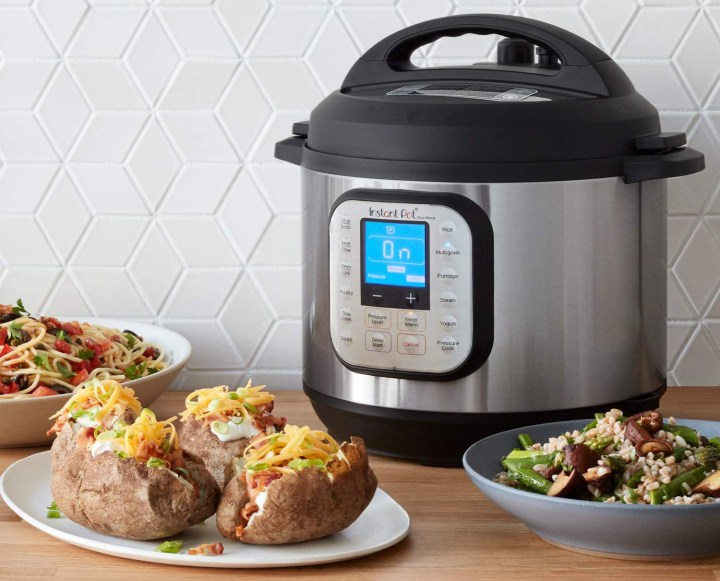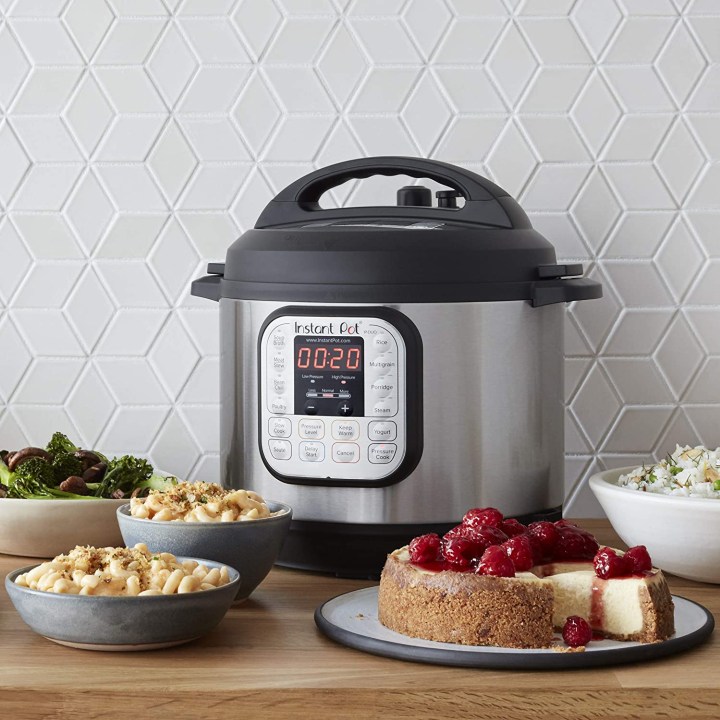While pressure cookers may look intimidating, many of today’s greatest pressure cookers are remarkably simple to operate. You can whip up some amazing entrees like curry and pot roast, whether you’re cooking overnight or leaving them to simmer while you’re at work. In this breakdown, we take a look at the fundamentals of pressure cooking, covering the device basics, and offering a few cooking suggestions of our own.
- What is a pressure cooker?
- How do I use a pressure cooker?
- How do I make sure the pressure is released?
- Which settings do I use?
- What can I cook in a pressure cooker?
- What’s the difference between a pressure cooker and a slow cooker?
- How do I use a pressure cooker at a high elevation?
- Is it healthy to cook in a pressure cooker?
- When was the pressure cooker invented?
- What are the issues when cooking with a pressure cooker?
What is a pressure cooker?

A pressure cooker is an airtight cooking device that cooks food quickly, thanks to the steam pressure that builds up inside. The steam makes the food moist, which is why this device is perfect for meat stews, cheesecakes, and much more. There are stovetop pressure cookers that use the heat of the stove, as well as countertop units that you plug into a wall outlet. Many plug-in pressure cookers boast other features and functions, like slow cooking, steaming, and sautéing in addition to pressure cooking.
How do I use a pressure cooker?
Getting to know your pressure cooker for the first time? Try pressure cooking with just water — this is called a water test, and it will help you get to know your machine better. All you have to do is add one or two cups of water into the pot (always use the inner pot, and never put food directly into the cooker without this pot for safety reasons). Lock the lid into position, and make sure to adjust the valve so that it is in the sealed position.
Next, select a button for which the cooking time is relatively short. For example, if your device has a button for fish, use that. You can also manually set the pressure cooking time for two or three minutes. Now, all you have to do is watch the pressure cooker do its magic. After a few minutes or so of the water heating up and building steam pressure, the pressure will then start counting down and slowly release. You should then be able to try it out with real food items.
How do I make sure the pressure is released?
This is a top concern among people who have never used pressure cookers before. The good news is that modern pressure cookers are very safe and easy to use. Most pressure cookers have a steam release valve, which you can move into the vent position to start releasing the pressure.
The easiest approach, however, is to just let the pressure cooker slowly release the pressure all by itself. Keep an eye on the countdown to make sure it’s complete — don’t try to open the lid before the countdown is up, or you could get burned (fortunately, many cookers lock the lid and prevent you from opening it before the pressure releases). Some cooks even like letting the pressure cooker sit for a little while longer past the countdown, just to make sure every last bit of pressure is gone.
Which settings do I use?
Most pressure cookers cook all foods in the same way, but there are different cooking times for different foods. For example, the preset button for white rice on your pressure cooker may cook for just 5 minutes, while brown rice will cook for longer. Even if you don’t have a convenient preset button on your pressure cooker, you can find out how long a type of food needs to cook and set the timer manually. We like the details given in the cooking time chart from Hip Pressure Cooking.
What can I cook in a pressure cooker?
The world is your oyster when it comes to cooking with an electric pressure cooker, whether you want to try making porridge, risotto, chicken, or soup. Since you’re not constantly stirring the pan, you’ll probably find that, in addition to the whole process being easier to manage, your food will also taste creamier than using the stovetop.
If you have a springform pan, you can even try making desserts like cakes and cheesecakes. If you have oven-safe dishes that can fit inside your pressure cooker, you can use them to separate ingredients like meats and vegetables to prevent flavors from mixing and even make yummy dishes like fajitas.
What’s the difference between a pressure cooker and a slow cooker?

The biggest difference between a pressure cooker and a slow cooker is speed. As the name suggests, a slow cooker relies on longer cooking times and lower temperatures. Slow cooking is great for stews, ribs, pulled pork, and chili — basically anything with meat that you want to get nice and tender. Pressure cookers form an airtight seal and use the internal pressure to cook food much more quickly than by just using heat alone. This makes short work out of denser foods, like rice, beans, and potatoes. The beauty of many modern pressure cookers is that they’ll often have a slow cooker setting, so there’s no need to get separate appliances.
How do I use a pressure cooker at a high elevation?
Pressure cooking remains a popular choice for high-altitude adventurers. In general, you’ll want to pressure cook food for 5% longer for every 1,000 feet above sea level beyond the first 2,000 feet. Lightweight pressure cookers built specifically for use at high elevations are available.
The boiling point of water drops due to lower atmospheric pressure. Since there’s less air above your pot, gasses have an easier time forming and escaping. As a result, traditional cooking times go up with altitude since boiling isn’t hitting the same level of heat needed for safe food. Increased cooking times and a higher rate of evaporation means dryer food. Pressure cookers can help maintain this moisture and offset the challenges of low air pressure in cooking.
Is it healthy to cook in a pressure cooker?
Pressure cooking is a great way to make healthy meals. Since cooking times are reduced, fewer vital nutrients are lost from the process compared to boiling or steaming. Of course, the healthiness of the meal will depend on the recipe.
When was the pressure cooker invented?
The pressure cooker was invented by French physicist Denis Papin in 1679, but didn’t enter mass production until 1864 in Germany.
What are the issues when cooking with a pressure cooker?
Safety is the major issue with pressure cookers. Though there are many safeguards in place with modern pressure cookers, damage or incorrect handling can cause the high-pressure steam to release suddenly, damaging anything in the vicinity. That said, since pressure cookers require a firm seal to function, having a sealing ring that’s degraded can slow your cooking time or halt it altogether as steam is gradually and continually released. Luckily pressure cookers allow for degraded sealing rings to be swapped out when the time comes.
If you’re in the market to pick up a pressure cooker, be sure to check out our picks for the best Instant Pots.
Editors' Recommendations
- What to do if your Amazon Alexa app is not working
- Red, green, flashing: What do my Shark vacuum’s lights mean?
- Can you use a Blink Outdoor Camera without a subscription?
- How often should you replace your robot vacuum?
- What is a smart lock and how does it work?





